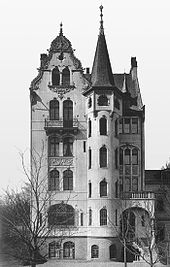Hans Grisebach (architect)

Hans Grisebach (born July 26, 1848 in Göttingen , † May 11, 1904 in Berlin ; full name Hans Otto Friedrich Julius Grisebach ) was a German architect . He was the son of the botanist August Grisebach .
plant
Grisebach realized various projects in the style of historicism and the German neo-renaissance , he is also referred to as the "architect of the Berlin Secession ".
Grisebach designed the chemistry pavilion for the world exhibition in Chicago in 1893 ( World's Columbian Exposition ) and the pavilion for the world exhibition in Paris 1900 . The most striking testimony of his work in Berlin is the elevated railway station “Schlesisches Tor” in Berlin-Kreuzberg (1899–1901), which, however , bears the signature of his partner August Dinklage , with whom he worked in a partnership from 1889 to 1901 , and for example also designed the Johanneskirche in Gießen and the Peterskirche in Frankfurt am Main. In Berlin-Charlottenburg , Fasanenstrasse 25, Grisebach built his own house ( Villa Grisebach ) in 1891/1892 , and nearby in 1902/1903 the house at Fasanenstrasse 39 based on the ideas of the client Dr. Richard Cleve, who also had components purchased there, preferably in Holland, built into the facade. Grisebach's most famous building, however, is likely to be the "Haus Wiesenstein" in Agnetendorf , Silesia , Gerhart Hauptmann's house , in which he lived until his death.
In general, Grisebach's buildings provided the backdrop for many prominent figures in German intellectual life. In the Breslau “ Villa Neisser ”, built in 1898 in Scheitniger Park for the well-known doctor Albert Neisser and his wife Toni, Gerhart Hauptmann, Gustav Mahler and Richard Strauss met next to them ; He built the "Villa Röhl" for the Wahllaender / Gropius family - it remained Walter Gropius ' summer house. He had friendly ties with Max Liebermann : Grisebach was brought in for the renovation of the Liebermann's house on Pariser Platz and for the design of the family grave; Liebermann, for his part, contributed mural paintings to “ Schloss Klink ”, which was built by Grisebach and Dinklage in 1896–1898 near Waren (Mecklenburg) for Arthur von Schnitzler . This castle is now a well-known excursion destination on the Müritz and is open to the public as a hotel. Even before Grisebach worked for Cologne by the industrialist he 1882-83 Paul Andreae its Good Mielenforst beplante new. The mansion was completed in 1885.
Another building in Grisebach is " Tremsbüttel Castle ", located near Bargteheide in northeast Hamburg. The Remscheid-based mining entrepreneur Alfred (Fritz) Hasenclever had the building, visible from afar, built in the historicist style for his wife Olga in 1893/1894 as a belated wedding present. This building has retained many details and elements inside and outside that Grisebach associated with the style of the time. Like Schloss Klink, Tremsbüttel is used as a hotel and restaurant and is therefore open to the public. The same applies to the Erbprinzenpalais in Wernigerode , which he built in 1893/1894 on behalf of Count Otto zu Stolberg-Wernigerode as a residence for the Count's Chamber President Rudolf Grisebach - his cousin. He also designed the “ Steinerne Renne ” hotel , the 1901 villa of the lawyer Hasert am Lindenberg in Wernigerode and the Landhaus Weise in Hasserode .
The architect Julius Graebner also worked temporarily in Grisebach's office .
family
Grisebach's son was the art historian August Grisebach , his daughter Eveline Grisebach (1890–1965). The architect Helmuth Grisebach, on the other hand, was his nephew.
literature
- Ekhart Berckenhagen (arrangement): Hans Grisebach. Architect of the early years. His drawings in the Berlin Art Library. Berlin 1974. (= Collection catalogs of the Berlin Art Library , Volume 7.)
- Uwe Kieling: Berlin private architect and master railroad builder in the 19th century. Biographical Lexicon. (= Miniatures on the history, culture and monument preservation of Berlin , Volume 26.) (edited by the Berlin district boards of the Society for Local History and for Monument Preservation in the Kulturbund der GDR) Berlin 1988. (with biographical data and a list of his buildings)
- Claudia Kromrei: Hans Grisebach: an architect and his work , Salenstein: niggli 2020, ISBN 978-3-7212-1010-1 .
- Irmgard Wirth: Grisebach, Hans Otto Friedrich Julius. In: New German Biography (NDB). Volume 7, Duncker & Humblot, Berlin 1966, ISBN 3-428-00188-5 , p. 99 f. ( Digitized version ).
Web links
- biographical data and catalog raisonné at www.historismus.net
- Hans Grisebach (architect) in the Magdeburg Biographical Lexicon
- Biography https://www.deutsche-biographie.de/sfz23825.html
| personal data | |
|---|---|
| SURNAME | Grisebach, Hans |
| BRIEF DESCRIPTION | German architect |
| DATE OF BIRTH | July 26, 1848 |
| PLACE OF BIRTH | Goettingen |
| DATE OF DEATH | May 11, 1904 |
| Place of death | Berlin |
